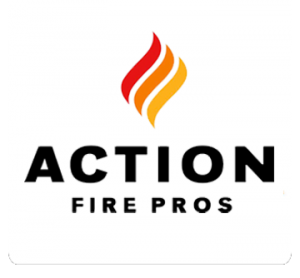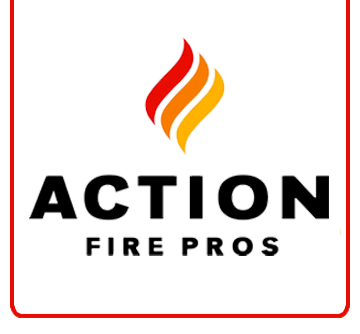We want to answer all your questions…
How is Action Fire Pros different from other protection companies?
We are a different kind of commercial fire protection company because in addition to being a “one-stop shop” for all types of fire protection, we live all three components of value-added customer service:
Responsiveness
Dependability
A job done right
Where are you located?
We have two offices to better take care of your fire protection needs.
- Serving the Dallas/Ft. Worth area at 3709 S I35E, Waxahachie TX.
- Serving the Waco/Killeen/Ft. Hood area at 200 Sharron Drive, Woodway TX.
How often do sprinkler gauges have to be replaced?
Every five years.
How long until Fire Marshal is notified for deficiency tags?
As required by the Texas State Fire Marshal, contractors must report the presence of a red or yellow tag as follows:
- Alarm or Sprinkler Inoperable Red Tag Notify immediately
- Alarm impaired Red Tag Within 3 business days
- Alarm or Sprinkler Yellow Tag Within 5 business days.
How often do fire extinguishers need to be serviced?
All portable fire extinguishers are required to have an Annual Fire Extinguisher Inspection performed by a state licensed inspector every year. In addition, most fire extinguishers are required to have maintenance performed on them every 6 years from the manufacture date of the extinguisher.
Please see list below for exact frequency of service and type of service required for the different types of extinguishers.
- ABC require an internal maintenance every 6 years and a hydrostatic test every 12 years from the date that the extinguisher was manufactured
- BC require an internal maintenance every 6 years and a hydrostatic test every 12 years from the date that the extinguisher was manufactured
- Class K require a hydrostatic test every 5 years from the date that the fire extinguisher was manufactured.
- Halon require an internal maintenance every 6 years and a hydrostatic test every 12 years from the date that the extinguisher was manufactured
- Halotron require an internal maintenance every 6 years and a hydrostatic test every 12 years from the date that the extinguisher was manufactured
- FE-36 require an internal maintenance every 6 years and a hydrostatic test every 12 years from the date that the extinguisher was manufactured
- Co2 require a hydrostatic test every 5 years from the date that the fire extinguisher was manufactured.
- Water require a hydrostatic test every 5 years from the date that the fire extinguisher was manufactured.
- Foam require a hydrostatic test every 5 years from the date that the fire extinguisher was manufactured. **Any time that a fire extinguisher has been partially discharged it needs to be completely recharged.
How do I tell if my extinguisher tags are current?
The month and the year that the fire extinguisher was last serviced or inspected is punched out on the tag along with the type of work that was performed. The fire extinguisher is current until the following year. Example if your annual fire extinguisher inspection or service was performed in March 2009, then maintenance, March and 2009 would be punched out on the tag which means you extinguisher is current until March of 2010.
How do I read the extinguisher gauge to see if it needs recharging?
There is a small green section at the very top of the gauge, the needle should be pointing in the green section which means it is correctly charged. If the needle is pointing in any other direction other than the green this indicates that your extinguisher is in need of recharging.
Why do I need to have my fire alarm or fire sprinkler system inspected?
All fire protection equipment is required to be inspected annually by City & State fire code. Some systems such as vent-a-hoods and FM200s are required on a semi-annual basis. In some instance a state agency or insurance company may require more frequent inspections.
Will you remind me when my inspections are due?
Yes, once Action does an inspection the information is entered into our database. We will contact you a month before your systems are due to get approval to schedule your next inspection.
What is done during a sprinkler/alarm inspection?
Annual Fire Sprinkler Inspection includes:
- Complete and thorough visual inspection of all sprinkler heads.
- Testing of the mechanical operation of waterflow, tamper switches and water motor gong.
- Flow test of main drain.
- Properly tagging for inspection and deficiencies found, if any.
- Inspection report for your records.
Annual Fire Alarm Inspection includes:
- Manual testing of all initiating devices such as pull stations and smoke detectors.
- Visual and audible inspection of operation for all notification devices such as horns and strobes.
- Test battery back-up systems.
- Verification of alarm signals with monitoring station.
- Properly tagging for inspection and deficiencies found, if any.
- Inspection report for your records.
What is a backflow? Why are these tested?
A backflow prevention assembly is a device which, when properly installed between the city water supply system and the point of ultimate use will prevent reversal of flow of water or mixtures of water and other liquids, gases or other substances into the distribution pipes of a potable water supply. Testing is essential to ensure these assemblies are working so that no contaminants enter the city water supply.
Do you send backflow reports to the city?
Yes, it is required by code for reports to be sent to the city.
Are your technicians licensed? What kind of license do they have ?
Action Fire Pros technicians are certified and hold the required state and city licenses to install, inspect, service and maintain all fire protection systems, including:
- Fire Sprinkler Systems
- Fire Alarm Systems
- Fire Extinguishers
- Vent-a-hoods
- Backflows
- Special Hazard Systems
What kind of benefits does Action offer for property managers?
- Keep track of inspection due dates so you don’t have to.
- Track type and locations of the systems on your properties.
- Send reports to insurance company or tenants by request.
- Complete fire protection company offering inspection and service on all products.
- One phone number for all your fire protection needs.
What is the pressure & density of my fire sprinkler system?
Typically a hydraulic calculation placard is installed at the riser providing this information. If not posted at the riser, the city may have this information archived at the building department or the original install contractor. The only other option is to have an engineer survey done.

